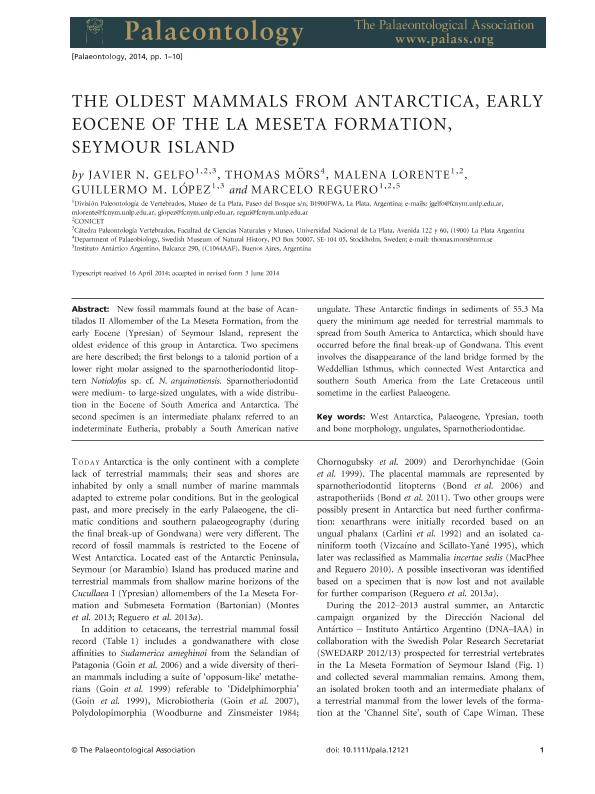Artículo
The oldest mammals from Antarctica, early Eocene of the La Meseta Formation, Seymour Island
Gelfo, Javier Nicolás ; Mörse, Thomas; Lorente, Malena
; Mörse, Thomas; Lorente, Malena ; López, Guillermo Marcos; Reguero, Marcelo Alfredo
; López, Guillermo Marcos; Reguero, Marcelo Alfredo
 ; Mörse, Thomas; Lorente, Malena
; Mörse, Thomas; Lorente, Malena ; López, Guillermo Marcos; Reguero, Marcelo Alfredo
; López, Guillermo Marcos; Reguero, Marcelo Alfredo
Fecha de publicación:
07/2014
Editorial:
Wiley Blackwell Publishing, Inc
Revista:
Palaeontology
ISSN:
0031-0239
Idioma:
Inglés
Tipo de recurso:
Artículo publicado
Clasificación temática:
Resumen
New fossil mammals found at the base of Acantilados II Allomember of the La Meseta Formation, from the early Eocene (Ypresian) of Seymour Island, represent the oldest evidence of this group in Antarctica. Two specimens are here described; the first belongs to a talonid portion of a lower right molar assigned to the sparnotheriodontid litoptern Notiolofos sp. cf. N. arquinotiensis. Sparnotheriodontid were medium- to large-sized ungulates, with a wide distribution in the Eocene of South America and Antarctica. The second specimen is an intermediate phalanx referred to an indeterminate Eutheria, probably a South American native ungulate. These Antarctic findings in sediments of 55.3 Ma query the minimum age needed for terrestrial mammals to spread from South America to Antarctica, which should have occurred before the final break-up of Gondwana. This event involves the disappearance of the land bridge formed by the Weddellian Isthmus, which connected West Antarctica and southern South America from the Late Cretaceous until sometime in the earliest Palaeogene
Archivos asociados
Licencia
Identificadores
Colecciones
Articulos(CCT - LA PLATA)
Articulos de CTRO.CIENTIFICO TECNOL.CONICET - LA PLATA
Articulos de CTRO.CIENTIFICO TECNOL.CONICET - LA PLATA
Citación
Reguero, Marcelo Alfredo; López, Guillermo Marcos; Lorente, Malena; Gelfo, Javier Nicolás; Mörse, Thomas; The oldest mammals from Antarctica, early Eocene of the La Meseta Formation, Seymour Island; Wiley Blackwell Publishing, Inc; Palaeontology; 58; 1; 7-2014; 101-110
Compartir
Altmétricas



